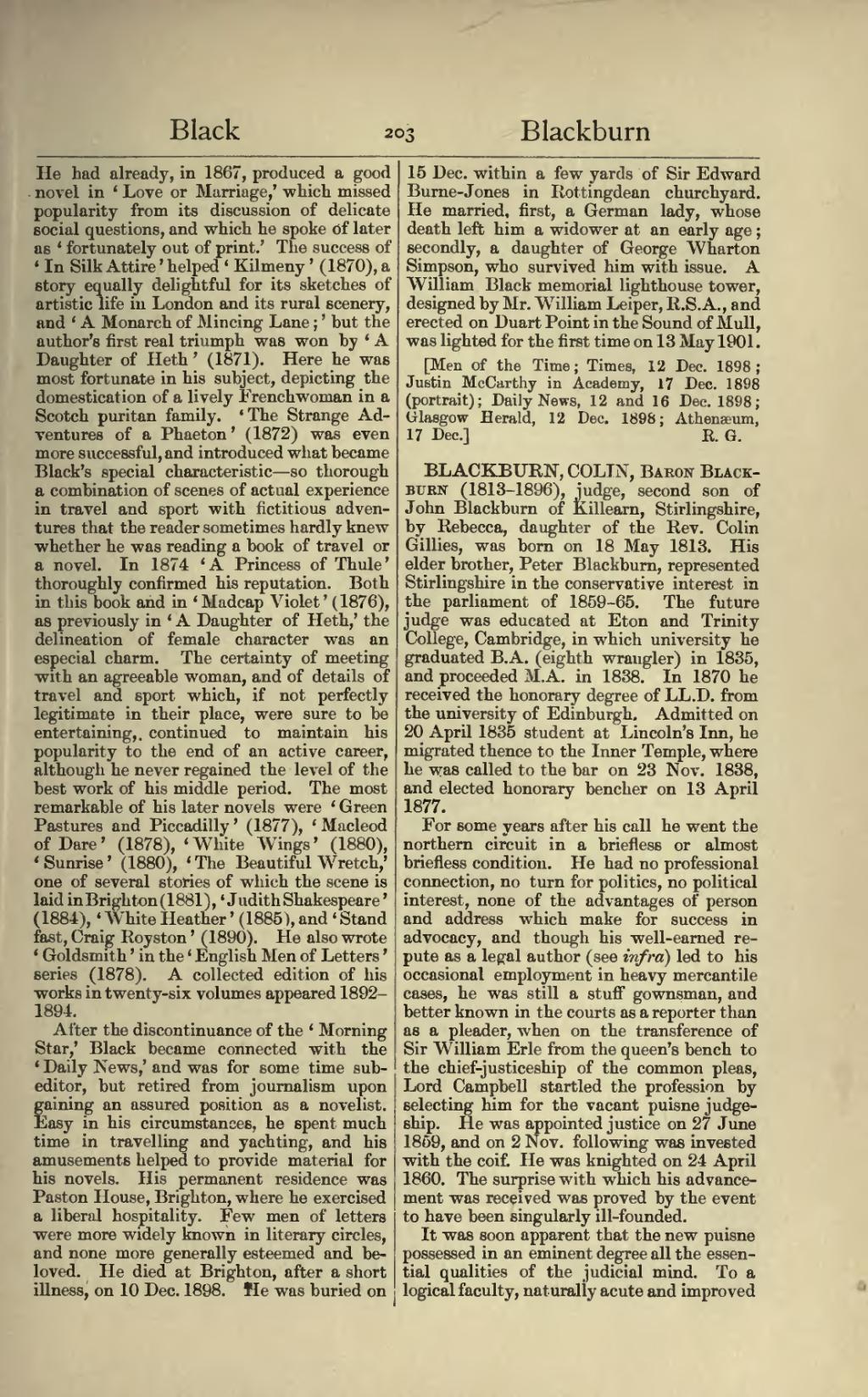He had already, in 1867, produced a good novel in 'Love or Marriage,' which missed popularity from its discussion of delicate social questions, and which he spoke of later as 'fortunately out of print.' The success of 'In Silk Attire' helped 'Kilmeny' (1870), a story equally delightful for its sketches of artistic life in London and its rural scenery, and 'A Monarch of Mincing Lane;' but the author's first real triumph was won by 'A Daughter of Heth' (1871). Here he was most fortunate in his subject, depicting the domestication of a lively Frenchwoman in a Scotch puritan family. 'The Strange Adventures of a Phaeton' (1872) was even more successful, and introduced what became Black's special characteristic — so thorough a combination of scenes of actual experience in travel and sport with fictitious adventures that the reader sometimes hardly knew whether he was reading a book of travel or a novel. In 1874 'A Princess of Thule' thoroughly confirmed his reputation. Both in this book and in 'Madcap Violet' (1876), as previously in 'A Daughter of Heth,' the delineation of female character was an especial charm. The certainty of meeting with an agreeable woman, and of details of travel and sport which, if not perfectly legitimate in their place, were sure to be entertaining,, continued to maintain his popularity to the end of an active career, although he never regained the level of the best work of his middle period. The most remarkable of his later novels were 'Green Pastures and Piccadilly' (1877), 'Macleod of Dare' (1878), 'White Wings' (1880), 'Sunrise' (1880), 'The Beautiful Wretch,' one of several stories of which the scene is laid in Brighton (1881), 'Judith Shakespeare' (1884), 'White Heather' (1885), and 'Stand fast, Craig Royston' (1890). He also wrote 'Goldsmith' in the 'English Men of Letters' series (1878). A collected edition of his works in twenty-six volumes appeared 1892-1894.
After the discontinuance of the 'Morning Star,' Black became connected with the 'Daily News,' and was for some time sub-editor, but retired from journalism upon gaining an assured position as a novelist. Easy in his circumstances, he spent much time in travelling and yachting, and his amusements helped to provide material for his novels. His permanent residence was Paston House, Brighton, where he exercised a liberal hospitality. Few men of letters were more widely known in literary circles, and none more generally esteemed and beloved. He died at Brighton, after a short illness, on 10 Dec. 1898. He was buried on 15 Dec. within a few yards of Sir Edward Burne-Jones in Rottingdean churchyard. He married, first, a German lady, whose death left him a widower at an early age; secondly, a daughter of George Wharton Simpson, who survived him with issue. A William Black memorial lighthouse tower, designed by Mr. William Leiper, R.S.A., and erected on Duart Point in the Sound of Mull, was lighted for the first time on 13 May 1901.
[Men of the Time; Times, 12 Dee. 1898; Justin McCarthy in Academy, 17 Dec. 1898 (portrait); Daily News, 12 and 16 Dec. 1898; Glasgow Herald, 12 Dec. 1898; Athenæum, 17 Dec.]
BLACKBURN, COLIN, Baron Blackburn (1813–1896), judge, second son of John Blackburn of Killearn, Stirlingshire, by Rebecca, daughter of the Rev. Colin Gillies, was born on 18 May 1813. His elder brother, Peter Blackburn, represented Stirlingshire in the conservative interest in the parliament of 1859-65. The future judge was educated at Eton and Trinity College, Cambridge, in which university he graduated B.A. (eighth wrangler) in 1835, and proceeded M.A. in 1838. In 1870 he received the honorary degree of LL.D. from the university of Edinburgh. Admitted on 20 April 1835 student at Lincoln's Inn, he migrated thence to the Inner Temple, where he was called to the bar on 23 Nov. 1838, and elected honorary bencher on 13 April 1877.
For some years after his call he went the northern circuit in a briefless or almost briefless condition. He had no professional connection, no turn for politics, no political interest, none of the advantages of person and address which make for success in advocacy, and though his well-earned repute as a legal author (see infra) led to his occasional employment in heavy mercantile cases, he was still a stuff gownsman, and better known in the courts as a reporter than as a pleader, when on the transference of Sir William Erie from the queen's bench to the chief-justiceship of the common pleas, Lord Campbell startled the profession by selecting him for the vacant puisne judgeship. He was appointed justice on 27 June 1859, and on 2 Nov. following was invested with the coif. He was knighted on 24 April 1860. The surprise with which his advancement was received was proved by the event to have been singularly ill-founded.
It was soon apparent that the new puisne possessed in an eminent degree all the essential qualities of the judicial mind. To a logical faculty, naturally acute and improved
